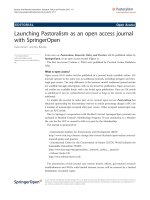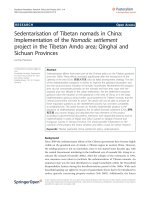Bendrey Pastoralism: Research, Policy and Practice 2011, 1:6 pot
Bạn đang xem bản rút gọn của tài liệu. Xem và tải ngay bản đầy đủ của tài liệu tại đây (152.67 KB, 4 trang )
BOO K REV I E W Open Access
Carol Ferret. Une civilisation du cheval
Robin Bendrey
1,2
Correspondence: r.
Full list of author information is
available at the end of the article
Book details
Paris: Belin; 2009
352 pages, ISBN 978-2-7011-4819-9
17 x 24 cm, 29 euros
Keywords: Horse; Ethnology; Yakutia; Inner Asia
En Asie intérieure, tout tourne autour du bétail et, parmi le bétail, le animal roi,
c’est le cheval. Libre et soumis, monté, bâté et attelé, battu, éreinté et sacrifié, trait,
mangé et corroyé, conté et chanté, c’ est le cheval tout entier qui est magnifié.
(p.16)
[In Inner Asia, all revolves around the livestock and, amongst the livestock, the horse
is king. Free and subjugated; used for riding, pack and traction; beaten, exhausted
and sacrificed; milked, eaten and curried;
a
celebrated in tales and songs: it is the
horse in all its forms that is glorified.]
This volume presents a study of the significant and co mplex role of the horse in the
cultures of Inner Asia.
b
Ferret primarily focuses on Yakutia, but also includes in her
study: Buryatia, Khakassia, a nd Tuva in Siberia, and Kazakhstan, Kyrgyzstan, Uzbeki-
stan, and Turkmenistan in Central Asia. This work derives from Ferret’ sdoctoral
research (entitled Techniques iakoutes aux confins de la civilisation altaïque du cheval,
Contribution à une anth ropologie de l’ action), and is based on field research underta-
ken continuous ly from 1993 to 1997, the n episodically until 2008. It takes a compara-
tive approach to the study of the cultures, focussing on Yakutia, but drawing parallels
with the other groups in her study area.
Ferret considers the inputs and outputs of Yakut horse husbandry. The former corre-
sponds to the activities of horse production by man, and the latter to everything that is
‘consumed’ (p.30-31). She considers the relationship between the inputs and outputs of
horse husbandry to be very unequal, with the h orse giving enormously in body
products and labour, for a minimum of care and maintenance (the Yakut horse lives
far from people, in a semi-wild state, and there are no stables and little food provided).
This volume deals with the various uses of the horse (i.e. consumption), and the breed-
ing and training of the horses (production) is dealt with in a separate publication
(Ferret 2010). Une civilisation du cheval consists of five main chapters, which are sup-
ported by a glossary of terms employed across the study region and a brief review of
the panoply of ethnic groups discussed in the volume.
Bendrey Pastoralism: Research, Policy and Practice 2011, 1:6
/>© 2011 Bendry; licensee Springer. This is an Open Access article distributed under the terms of the Creative Commons Attribution
License ( http ://creativecommons.org/licenses/by/2.0), which p ermits unrestricted use, distribution, and reproduction in any med ium,
provided the original work is properly cited.
The Yakut horse itself is a remarkable animal, surviving through the harsh winters of
Yakutia (the coldest recorded temperature is -70°C !). The characterist ics and pedigree
of this animal is the subject of Chapter 1. The exceptional adaptation of this animal to
this environment is underlined through comparisons to crossbred horses [horses
produced by crossbreeding Yakut horses with other races with the aim of improving
certain qualities, whilst still retaining its resistance and rusticity (p.68)]. Ferret
describes how Yakut opponents to cr ossbreeding believe that these hybrid animals are
less able to deal with the cold, having a lower density of hair per unit area (p. 55 and
69). I ndeed, recent experiments measuring body temperature fluctuations throughout
the year have shown that purebred Yakut horses are better able to maintain a constant
body temperature throughout the year than crossbred animals (Anufriev et al. 2009).
This chapter also discusses variations in herd compositions through time and space.
Various cultural factors can be seen influencing the representation of speci es, such as
the reduction in the use of the horse for transport through the twentieth century and
food taboo s: Russians are not horsemeat eaters, unlike the Yakut; whereas in Yakutia,
pigs (introduced by the Russians) were for a long time looked down upon, and even
now only constitute a minority of animals kept (p.42, 46). The role of the environment
is evident in the distribution of domestic species in the countries of the study region -
for example in Yakutia at the north-eastern limit of the study area, horses make up
over one quarter of domestic herds and there is a notable absence of sheep, whereas at
the south-western end of the study area, hot and dry T urkmenistan boasts over 50%
sheep, and a negligible proportion of horses (p.41). Although discussed, the importance
of the environment and the extent to which it influences animal husbandry is not ul ti-
mately given sufficient weight. In the conclusion to the book, Ferret considers general
horse husbandry models for the cultures across the study area, within which she com-
pares h orse population numbers to those o f the human inhabitants (p.308), but does
not discuss the role of the environmen t in this identified pattern. It is of course possi-
ble to raise animals in environment s outside of the ir ‘comfort zones’, but this requires
greater investment by humans than for species better adapted to those environments
(as seen in the contrast in input for Yakut cattle and horse described by Ferret), and it
remains a fact that there are environmental, biological and behavioural factors which
will affect animal populations and their suitability to different regions (e.g. Kerven
et al. 1996,; Temple 1984).
The dietary uses of horse are presented in Chapter 2, the focus of which is predomi-
nantly on meat rather than milk. Most of Ferret’s Yakut infor mants deemed the meat
of foals to b e of higher quality than that of adult horses, and Ferret describes a hus-
bandry regime in which half o f the new foals born each year are culled at aroun d six
months of age, at weaning. Those culled in this autu mn slaughter are predominantly
males, as these are not needed in large numbers for the reproductive needs of the
herds. Ferret also argues that this system is logical in terms of the minimisation of
production input, as it reduces the quantities of f odde r needed to be collected for the
following winter. Details of meat preparation, conservation and consumption are also
given. Compared to meat, milk contributes less in quantity to the diet, but is of consid-
erable social significance. Mares’ milk is consumed exclusively in its fermented form, as
the lightly alcoholic koumiss. Ferret describes the production, consumption and social
significance of this drink.
Bendrey Pastoralism: Research, Policy and Practice 2011, 1:6
/>Page 2 of 4
Beyondthedietaryuseofhorses,theYakuts also exploit almost all parts of the
horse. Chapter 3 deals with the non-dietary uses of body parts and products: skins,
hair, bone, tendons, hooves, melanomas (melanomas, which develop under the tail,
near to the anus, in elderly horses, are used in the production of black dyes), excre-
tions and se cretion s. The latter t wo consist of: dung, urine, sweat, saliva, placenta, and
bezoars (bezoars are accumulations of foreign material in the stomach of the horse,
and are awarded magical powers; being principally used to modify/influence the
weather ). Ferret describes and ill ustr ates the diverse products and uses for these body
products, and their manner of fabrication, from sun glasses made from horse hair - the
eyes are protected by a mesh of intertwined hairs (p.135) - to the use of the placenta as
a cure for female sterility in southern Kazakhstan (p.152).
Chapter 4 deals with the work use of the horse, which is primarily as a pack, traction
and riding animal. The full modern range of socioeconomic roles ar e elaborated by Fer-
ret, from agricultural work to horse racing; as well as its use in the past, including,
importantly, in warfare - a use which has, quite literally, contributed to shaping the
course of human history. This cha pter include s detailed descriptions of the accoutre-
ments of horse use for transport (harnesses, saddles, vehicles and so on) all richly illu-
strated. T he important role of the horse for transport can be seen in the units employed
to measure distance that are calibrated in terms of the animals, such as the distance cov-
ered by a horse in a day. In describing the latter idea, F erret neatly leads us into the last
of the main chapters of the bo ok. Chapter 5 deals with the cultural significance of the
horse in terms of what the horse represents to society rather than those uses providing
physical contributions (e.g. body products andwork).Ferretdiscussesitsrolesasan
index of wealth, a monetary unit, an animal of sacrifice, and an icon in art and craft pro-
duction. Ferret describes in detail the pract ices of horse sacrifice and burial alongside
deceased humans across Inner Asia, and the longevity of these practices - stretching
back in time t o the early first millennium BC. In these early Iron Age burial mounds we
catch a glimpse of the great significance of the horse to the past peoples of Inner Asia,
with the impressive kurgan at Arzhan, Tuva, containing some 160 sacrificed horses.
This is a major scholarly work and there is not enough space here to do justice to
the range of material covered. Une civilisation du cheval is an exceedingly rich and
finely detailed publication. It is well illustrated, es sential for the nature of the study,
which also makes the book a pleasure to read. The strength of this book lies in the
detail provided by Ferret’s long association and immersion in these cultures. Ferret has
cast her net wide - covering a vast area of the Asian continent, with considerable varia-
bility in natural environments (steppe, desert, mountain, taiga, and tundra) - all of
which is united by the clear importance with which the various cultures hold the
horse. Ho wever, the importance and role of the horse is by no means u niform across
this area, a point ably demonstrated by Ferret’s c omparative approach. In this book,
Ferret has achieved a unique and intimate portrait of horse use in Inner Asia, and I
very much look forward to reading the sister volume.
Endnotes
a
To curry ( corroyer ), here, is used in the sense of preparing (tanned hides) for use.
b
Ferret uses the term “Asie intérieure” , to define her geographic study zone, which
stretches from Turkmenistan to Yakutia (p.23).
Bendrey Pastoralism: Research, Policy and Practice 2011, 1:6
/>Page 3 of 4
Author details
1
UMR 7209 du CNRS, Muséum Nationale d’Histoire Naturelle, Paris 75005, France
2
Current address; Department of
Archaeology, University of Reading, Whiteknights Box 226, Reading, RG6 6AB, UK.
Competing interests
The author declares that they have no competing interests.
Received: 15 March 2011 Accepted: 9 May 2011 Published: 9 May 2011
References
Anufriev, AI, VF Yadrikhinskii, and AP Isaev. 2009. Body temperature in purebred and hybrid Yakut horses under the
conditions of Yakutia. Doklady Biological Sciences 427: 358–361.
Ferret, C. 2010. Techniques d’élevage et de dressage du cheval en Asie intérieure. Contribution à une anthropologie de
l’action. Louvain: Peeters.
Kerven, C, J Channon, and R Behnke. 1996. Planning and policies on extensive livestock development in Central Asia
(Overseas Development Institute Working Paper 91). London; Overseas Development Institute.
Temple, RS. 1984. Livestock populations and factors affecting them. In Development of animal production systems, ed.
Nestel B 33–61. Amsterdam: Elsevier.
doi:10.1186/2041-7136-1-6
Cite this article as: Bendrey: Carol Ferret. Une civilisation du cheval. Pastoralism: Research, Policy and Practice 2011
1:6.
Submit your manuscript to a
journal and benefi t from:
7 Convenient online submission
7 Rigorous peer review
7 Immediate publication on acceptance
7 Open access: articles freely available online
7 High visibility within the fi eld
7 Retaining the copyright to your article
Submit your next manuscript at 7 springeropen.com
Bendrey Pastoralism: Research, Policy and Practice 2011, 1:6
/>Page 4 of 4









